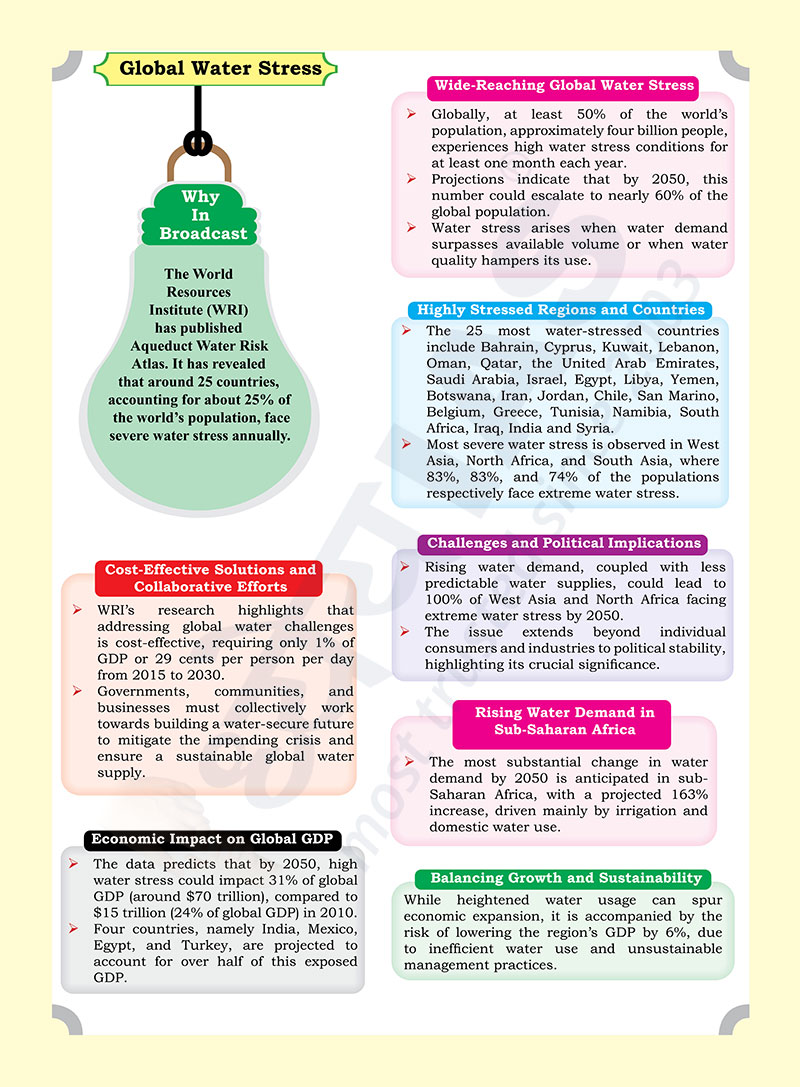Brain-booster
/
19 Sep 2023
Brain Booster for UPSC & State PCS Examination (Topic: Global Water Stress)

Why in Broadcast?
- The World Resources Institute (WRI) has published Aqueduct Water Risk
Atlas. It has revealed that around 25 countries, accounting for about 25% of
the world’s.
Wide-Reaching Global Water Stress
- Globally, at least 50% of the world’s population, approximately four
billion people, experiences high water stress conditions for at least one
month each year.
- Projections indicate that by 2050, this number could escalate to nearly
60% of the global population.
- Water stress arises when water demand surpasses available volume or when
water quality hampers its use.
Highly Stressed Regions and Countries
- The 25 most water-stressed countries include Bahrain, Cyprus, Kuwait,
Lebanon, Oman, Qatar, the United Arab Emirates, Saudi Arabia, Israel, Egypt,
Libya, Yemen, Botswana, Iran, Jordan, Chile, San Marino, Belgium, Greece,
Tunisia, Namibia, South Africa, Iraq, India and Syria.
- Most severe water stress is observed in West Asia, North Africa, and
South Asia, where 83%, 83%, and 74% of the populations respectively face
extreme water stress.
Challenges and Political Implications
- Rising water demand, coupled with less predictable water supplies, could
lead to 100% of West Asia and North Africa facing extreme water stress by
2050.
- The issue extends beyond individual consumers and industries to
political stability, highlighting its crucial significance.
Rising Water Demand in Sub-Saharan Africa
- The most substantial change in water demand by 2050 is anticipated in
sub-Saharan Africa, with a projected 163% increase, driven mainly by
irrigation and domestic water use.
Balancing Growth and Sustainability
- While heightened water usage can spur economic expansion, it is
accompanied by the risk of lowering the region’s GDP by 6%, due to
inefficient water use and unsustainable management practices.
Economic Impact on Global GDP
- The data predicts that by 2050, high water stress could impact 31% of
global GDP (around $70 trillion), compared to $15 trillion (24% of global
GDP) in 2010.
- Four countries, namely India, Mexico, Egypt, and Turkey, are projected
to account for over half of this exposed GDP.
Cost-Effective Solutions and Collaborative Efforts
- WRI’s research highlights that addressing global water challenges is
cost-effective, requiring only 1% of GDP or 29 cents per person per day from
2015 to 2030.
- Governments, communities, and businesses must collectively work towards
building a water-secure future to mitigate the impending crisis and ensure a
sustainable global water supply.







